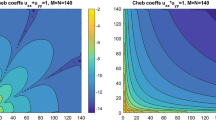Abstract
Recently, both companion-matrix methods and subdivision algorithms have been developed for finding the zeros of a truncated spectral series. Since the Chebyshev or Legendre coefficients of derivatives of a function f(x) can be computed by trivial recurrences from those of the function itself, it follows that finding the maxima, minima and inflection points of a truncated Chebyshev or Fourier series f N (x) is also a problem of finding the zeros of a polynomial when written in truncated Chebyshev series form, or computing the roots of a trigonometric polynomial. Widely scattered results are reviewed and a few previously unpublished ideas sprinkled in. There are now robust zerofinders for all species of spectral series. A transcendental function f(x) can be approximated arbitrarily well on a real interval by a truncated Chebyshev series f N (x) of sufficiently high degree N. It follows that through Chebyshev interpolation and Chebyshev rootfinders, it is now possible to easily find all the real roots on an interval for any smooth transcendental function.
Similar content being viewed by others
References
Boyd JP (2004) A review of high-order methods for incompressible fluid flow by M. O. Deville, P. F. Fischer and E. H. Mund. SIAM Rev 46:151–157
Boyd JP (1995) A Chebyshev polynomial interval-searching method (“Lanczos economization”) for solving a nonlinear equation with application to the nonlinear eigenvalue problem. J Comput Phys 118:1–8
Boyd JP (2002) Computing zeros on a real interval through Chebyshev expansion and polynomial rootfinding. SIAM J Num Anal 40:1666–1682
Boyd JP (2006) Finding the roots of a transcendental equation: how Chebyshev polynomials, algebraic geometry and matrix theory have solved a quest begun in Babylon. Math Intell submitted
Weidner P (1988) The Durand–Kerner method for trigonometric and exponential polynomials. Computing 40:175–179
Battles Z, Trefethen LN (2004) An extension of Matlab to continuous functions and operators. SIAM J Sci Comp 25:1743–1770
Toh K, Trefethen LN (1994) Pseudozeros of polynomials and pseudospectra of companion matrices. Num Math 68:403–425
Parlett BN, Reinsch C (1969) Balancing a matrix for calculation of eigenvalues and eigenvectors. Num Math 13:293–304
Boyd JP, Gally DH (2005) Numerical experiments on the accuracy of the Chebyshev–Frobenius companion matrix method for finding the zeros of a truncated series of Chebyshev polynomials. J Comp Appl Math (in proof)
Boyd JP (2001) Chebyshev and Fourier spectral methods 2nd edn. Dover, Mineola, New York
Jónsson GF, Vavasis S (2004) Solving polynomials with small leading coefficients. SIAM J Matrix Anal Appl 26:400–414
Boyd JP (2006) Computing the zeros of a Fourier series or a Chebyshev series or general orthogonal polynomial series with parity symmetries. Comput Math Appl submitted
Day D, Romero L (2005) Roots of polynomials expressed in terms of orthogonal polynomials. SIAM J Num Anal 43:1969–1987
Boyd JP (2006) Computing real roots of a polynomial in Chebyshev series form through subdivision. Appl Num Math in proof
Boyd JP (2006) Computing real roots of a polynomial in Chebyshev series form through subdivision with linear testing and cubic solves. Appl Math Comp 174:1642–1648
Boyd JP (2006) A test for an interval to be free of zeros for polynomials in Chebyshev form through conversion to the Bernstein polynomial basis. Appl Math Comp submitted
Boyd JP (2006) Rootfinding for a transcendental equation without a first guess: Polynomialization of Kepler’s equation through Chebyshev polynomial expansion of the sine. Appl Num Math 52:12–18
Fraser W, Wilson MW (1966) Remarks on the Clenshaw–Curtis quadrature scheme. SIAM Rev 8:322–327
Sloan IH, Smith WE (1980) Product integration with the Clenshaw–Curtis quadrature scheme. SIAM Rev 8:322–327
Trefethen LN, Schreiber RS (1990) Average-case stablity of Gaussian elimination. SIAM J Matrix Anal Appl 11:335–360
Clenshaw CW, Curtis AR (1960) A method for numerical integration on an automatic computer. Num Math 2:197–205
Jacobs SJ (1990) A variable order pseudospectral method for two-point boundary value problems. J Comp Phys 88:169–182
Mason JC, Handscomb DC (2003) Chebyshev polynomials. Chapman and Hall/CRC press, Boca Raton, Florida
Specht W (1957) Die Lage der Nullstellen eines Polynom III. Math Nach 16:369–389
Specht W (1960) Die Lage der Nullstellen eines Polynom IV. Math Nach 21:201–222
Barnett S (1975) Companion matrix analog for orthogonal polynomials. Linear Algebra Appl 12:197–208
Stetter HJ (2004) Numerical polynomial algebra, Society for Industrial and Applied Mathematics. Philadelphia, Pennsylvania
Gol’berg EM, Malozemov VN (1979) Estimates for the zeros of certain polynomials. Vestmol Leningrad Univ Math 6:127–135. Translated from Vestnik Leningrad Univ Mat Mekh Astr 7(1973), 18–24
Angelova ED, Semerdzhiev KI (1982) Methods for the simulataneous approximate derivation of the roots of algebraic, trigonometric and exponential equations. USSR Comp Maths Math Phys 22:226–232
Makrelov IV, Semerdzhiev HI (1985) Methods for the simultaneous determination of all zeros algebraic, trigonometric and exponential equations. USSR Comp Maths Math Phys 24:1443–1453
Makrelov IV Semerdzhiev HI (1985) On the convergence of two methods for the simultaneous find of all roots of exponential equations. IMA J Num Anal 5:191–200
Frommer A (1988) A unified approach to methods for the simulataneous computation of all zeros of generalized polynomials. Num Math 54:105–116
Schweikard A (1991) Trigonmetric polynomials with simple roots. Inform Process Lett 39:231–236
Schweikard A (1992) Real zero isolation for trigonmetric polynomials. ACM Trans Math Software 18:350–359
Carstensen C, Petkovi’c MS (1993) On some interval methods for algebraic, exponential and trigonomertric polynomials. Computing 51:313–326
Carstensen C, Reinders M (1993) On a class of higer order methods for simultaneous rootfinding of generalized polynomials. Num Math 64:69–84
Carstensen C (1994) A note on simulataneous rootfinding for algebraic, exponential, and trigonomertric polynomials. Comp Math Appl 27:7–14
Author information
Authors and Affiliations
Corresponding author
Rights and permissions
About this article
Cite this article
Boyd, J.P. Computing the zeros, maxima and inflection points of Chebyshev, Legendre and Fourier series: solving transcendental equations by spectral interpolation and polynomial rootfinding. J Eng Math 56, 203–219 (2006). https://doi.org/10.1007/s10665-006-9087-5
Received:
Accepted:
Published:
Issue Date:
DOI: https://doi.org/10.1007/s10665-006-9087-5



